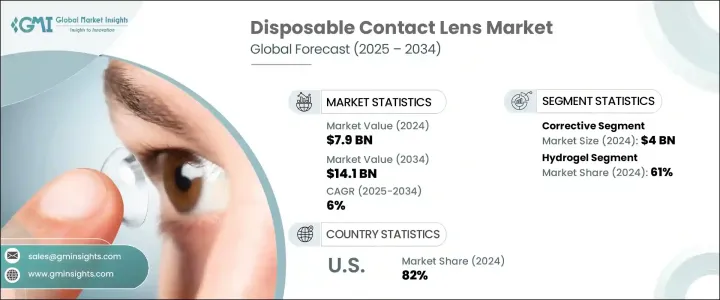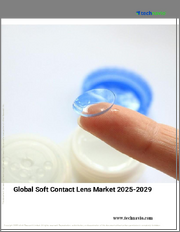
|
시장보고서
상품코드
1740823
세계의 일회용 콘택트렌즈 시장 : 기회, 성장 촉진요인, 산업 동향 분석, 예측(2025-2034년)Disposable Contact Lens Market Opportunity, Growth Drivers, Industry Trend Analysis, and Forecast 2025 - 2034 |
||||||
세계의 일회용 콘택트렌즈 시장은 2024년 79억 달러로 평가되었고, CAGR 6%로 성장해 2034년까지 141억 달러에 이를 것으로 추정되고 있습니다.
이 성장 궤도는 아이 케어에 대한 의식의 높아짐, 렌즈 기술의 끊임없는 혁신, 편리성과 위생을 우선하는 소비자의 기호의 변화 등 다양한 요인에 의해 뒷받침되고 있습니다. 효과적이고 편안한 시력 교정 옵션의 필요성이 현저하게 높아지고 있습니다.

이 수요 증가의 주요 요인은 근시와 원시 등의 굴절성 시력 장애의 발생률 증가입니다. 일회용 콘택트렌즈는 매끄럽고 안경을 필요로 하지 않는 시력 교정 체험을 제공할 수 있는 점에서 인기를 모으고 있습니다. 많은 소비자들은 장시간의 렌즈 착용과 관련된 위험을 최소화하기 위해 하루 일회용 렌즈와 단기간 일회용 렌즈에 눈을 돌리고 있습니다.
| 시장 범위 | |
|---|---|
| 시작 연도 | 2024년 |
| 예측 연도 | 2025-2034년 |
| 시작 금액 | 79억 달러 |
| 예측 금액 | 141억 달러 |
| CAGR | 6% |
시장은 제품 유형에 따라 교정용 렌즈, 미용용 렌즈, 치료용 렌즈 등으로 구분됩니다. 이 중 교정 렌즈 분야는 2024년에 약 40억 달러의 수익 공유를 차지했습니다. 난시나 노안을 포함한 시력 상태에 걸치는 사람 증가는 교정용 콘택트렌즈 수요를 밀어 올리고 있습니다.
사용되는 소재의 관점에서 일회용 콘택트렌즈 시장은 하이드로겔과 폴리머로 분류됩니다. 하이드로겔 렌즈는 보습성이 뛰어나므로, 다른 유형의 렌즈로 건조나 불쾌감을 느끼는 사람에게 선호되고 있습니다.
지역적으로는 미국이 북미 일회용 콘택트렌즈 시장에서 지배적인 지위를 차지하고 있으며, 2024년에는 지역 점유율의 약 82%를 차지했습니다. 모든 연령층에서 디지털 기기가 널리 사용되고 있어 시력과 관련된 문제가 보다 일반적으로 되어 일회용 렌즈 수요가 높아지고 있습니다.
경쟁 구도으로는 세계적으로 입증 된 기업과 혁신적인 신규 진출기업이 혼재하고 있습니다. 시장 성장에 크게 공헌하는 선구적인 기업으로는 Alcon, Abbott Laboratories, Bausch + Lomb, Carl Zeiss, BenQ Materials Corporation, CooperVision, Hoya Corporation, Essilor International, Hydron International, Keratron, Johnson & Johnson Vision Care, Menicon, Miru, Toric Contact Lenses, Vision Direct 등이 있습니다.
목차
제1장 조사 방법과 범위
제2장 주요 요약
제3장 업계 인사이트
- 생태계 분석
- 밸류체인에 영향을 주는 요인
- 이익률 분석
- 혁신
- 미래의 전망
- 제조업자
- 리셀러
- 공급자의 상황
- 이익률 분석
- 주요 뉴스와 대처
- 규제 상황
- 영향요인
- 성장 촉진요인
- 기술적 진보
- 시각장애 증가
- 업계의 잠재적 위험 및 과제
- 시장의 포화와 치열한 경쟁
- 지속가능성에 대한 우려
- 성장 촉진요인
- 성장 가능성 분석
- Porter's Five Forces 분석
- PESTEL 분석
제4장 경쟁 구도
- 소개
- 기업의 시장 점유율 분석
- 경쟁 포지셔닝 매트릭스
- 전략적 전망 매트릭스
제5장 시장 추계 및 예측 : 제품 유형별, 2021-2034년
- 주요 동향
- 교정
- 화장품 렌즈
- 치료용 렌즈
- 기타(인공 렌즈 등)
제6장 시장 추계 및 예측 : 재료별, 2021-2034년
- 주요 동향
- 하이드로겔
- HEMA 하이드로겔
- 실리콘 하이드로겔
- 폴리머
- 폴리비닐알코올
- 경질 가스 투과성
제7장 시장 추계 및 예측 : 디자인별, 2021-2034년
- 주요 동향
- 토릭
- 구형
- 다초점
- 기타(원근 양용 등)
제8장 시장 추계 및 예측 : 용도별, 2021-2034년
- 주요 동향
- 매일 사용
- 매주 사용
- 매월 사용
- 연간 사용
제9장 시장 추계 및 예측 : 유통채널별, 2021-2034년
- 주요 동향
- 온라인
- 전자상거래
- 기업 웹사이트
- 오프라인
- 안경점
- 안과 클리닉
제10장 시장 추계 및 예측 : 지역별, 2021-2034년
- 주요 동향
- 북미
- 미국
- 캐나다
- 유럽
- 영국
- 독일
- 프랑스
- 이탈리아
- 스페인
- 러시아
- 아시아태평양
- 중국
- 인도
- 일본
- 한국
- 호주
- 라틴아메리카
- 브라질
- 멕시코
- 중동 및 아프리카
- 아랍에미리트(UAE)
- 사우디아라비아
- 남아프리카
제11장 기업 프로파일
- Abbott Laboratories
- Alcon
- Bausch Lomb
- BenQ Materials Corporation
- Carl Zeiss
- CooperVision
- Essilor International
- Hoya Corporation
- Hydron International
- Johnson & Johnson Vision Care
- Keratron
- Menicon
- Miru
- Toric Contact Lenses
- Vision Direct
The Global Disposable Contact Lens Market was valued at USD 7.9 billion in 2024 and is estimated to grow at a CAGR of 6% to reach USD 14.1 billion by 2034. This growth trajectory is fueled by a variety of factors, including rising awareness about eye care, continuous innovations in lens technology, and shifting consumer preferences that prioritize convenience and hygiene. As the global population becomes increasingly susceptible to vision problems, the need for effective and comfortable vision correction options has grown significantly. Disposable contact lenses, which offer a blend of visual clarity and ease of use, are quickly becoming a go-to solution for individuals across different age groups.

A key contributor to this rising demand is the growing incidence of refractive vision conditions, such as nearsightedness and farsightedness. These issues are becoming more widespread due to changing lifestyles and increased exposure to screens, especially in densely populated and fast-developing areas. As these conditions become more prevalent, particularly among younger demographics, more people are choosing disposable lenses to avoid the discomfort and maintenance associated with traditional eyewear. Disposable contact lenses are gaining popularity for their ability to provide a seamless, glasses-free vision correction experience. Additionally, with the rising awareness about maintaining good eye hygiene, many consumers are turning to daily and short-term disposable lenses to minimize the risks associated with extended lens wear.
| Market Scope | |
|---|---|
| Start Year | 2024 |
| Forecast Year | 2025-2034 |
| Start Value | $7.9 Billion |
| Forecast Value | $14.1 Billion |
| CAGR | 6% |
The market is segmented based on product type into corrective lenses, cosmetic lenses, therapeutic lenses, and others. Among these, the corrective lens segment held a revenue share of approximately USD 4 billion in 2024. This segment is forecasted to grow at a CAGR of around 6.2% from 2025 to 2034. The increasing number of people affected by vision conditions, including astigmatism and presbyopia, continues to push demand for corrective contact lenses. Many individuals are seeking reliable and comfortable alternatives to glasses, making disposable corrective lenses a compelling option for everyday use.
In terms of materials used, the disposable contact lens market is categorized into hydrogel and polymers. The hydrogel segment captured nearly 61% of the overall market share in 2024 and is expected to maintain steady growth at a CAGR of 6.3% during the forecast period. Hydrogel lenses are favored for their moisture-retaining properties, making them a preferred choice for individuals who experience dryness or discomfort with other types of lenses. These lenses are particularly appealing to new users due to their soft texture and ability to stay hydrated throughout the day, enhancing overall comfort during prolonged use.
From a geographical standpoint, the United States commands a dominant position in the North American disposable contact lens market, accounting for approximately 82% of the regional share in 2024. The high adoption rate of contact lenses in the country can be linked to the increasing prevalence of vision disorders and the growing need for practical vision correction solutions. With the widespread use of digital devices across all age groups, vision-related issues are becoming more common, driving demand for disposable lenses. The convenience and aesthetic benefits of these lenses make them an attractive alternative to traditional glasses, especially for individuals seeking flexibility and improved appearance.
The competitive landscape of the disposable contact lens market includes a mix of established global players and innovative newcomers. Leading companies actively contributing to market growth include Alcon, Abbott Laboratories, Bausch + Lomb, Carl Zeiss, BenQ Materials Corporation, CooperVision, Hoya Corporation, Essilor International, Hydron International, Keratron, Johnson & Johnson Vision Care, Menicon, Miru, Toric Contact Lenses, and Vision Direct. These firms are consistently investing in product development, leveraging new materials, and enhancing user experience to stay competitive in a fast-evolving market.
Table of Contents
Chapter 1 Methodology & Scope
- 1.1 Market scope & definitions
- 1.2 Base estimates & calculations
- 1.3 Forecast calculations.
- 1.4 Data sources
- 1.4.1 Primary
- 1.4.2 Secondary
- 1.4.2.1 Paid sources
- 1.4.2.2 Public sources
Chapter 2 Executive Summary
- 2.1 Industry synopsis, 2021-2034
Chapter 3 Industry Insights
- 3.1 Industry ecosystem analysis
- 3.1.1 Factor affecting the value chain.
- 3.1.2 Profit margin analysis.
- 3.1.3 Disruptions
- 3.1.4 Future outlook
- 3.1.5 Manufacturers
- 3.1.6 Distributors
- 3.2 Supplier landscape
- 3.3 Profit margin analysis.
- 3.4 Key news & initiatives
- 3.5 Regulatory landscape
- 3.6 Impact forces
- 3.6.1 Growth drivers
- 3.6.1.1 Technological advancements
- 3.6.1.2 Increasing number of visionary problems
- 3.6.2 Industry pitfalls & challenges
- 3.6.2.1 Market saturation and intense competition
- 3.6.2.2 Sustainability concerns
- 3.6.1 Growth drivers
- 3.7 Growth potential analysis
- 3.8 Porter's analysis
- 3.9 PESTEL analysis
Chapter 4 Competitive Landscape, 2023
- 4.1 Introduction
- 4.2 Company market share analysis
- 4.3 Competitive positioning matrix
- 4.4 Strategic outlook matrix
Chapter 5 Market Estimates & Forecast, By Product Type, 2021-2034 (USD Billion) (Million Units)
- 5.1 Key trends
- 5.2 Corrective
- 5.3 Cosmetics lens
- 5.4 Therapeutic lens
- 5.5 Others (prosthetic lens, etc.)
Chapter 6 Market Estimates & Forecast, By Material, 2021-2034 (USD Billion) (Million Units)
- 6.1 Key trends
- 6.2 Hydrogel
- 6.2.1 HEMA hydrogel
- 6.2.2 Silicone hydrogel
- 6.3 Polymers
- 6.3.1 Polyvinyl alcohol
- 6.3.2 Rigid gas permeable
Chapter 7 Market Estimates & Forecast, By Design, 2021-2034 (USD Billion) (Million Units)
- 7.1 Key trends
- 7.2 Toric
- 7.3 Spherical
- 7.4 Multifocal
- 7.5 Others (bifocal, etc.)
Chapter 8 Market Estimates & Forecast, By Usage, 2021-2034 (USD Billion) (Million Units)
- 8.1 Key trends
- 8.2 Daily disposable
- 8.3 Weekly disposable
- 8.4 Monthly disposable
- 8.5 Annual
Chapter 9 Market Estimates & Forecast, By Distribution Channel, 2021-2034 (USD Billion) (Million Units)
- 9.1 Key trends
- 9.2 Online
- 9.2.1 E commerce
- 9.2.2 Company websites
- 9.3 Offline
- 9.3.1 Optical stores
- 9.3.2 Eye care clinics
Chapter 10 Market Estimates & Forecast, By Region, 2021-2034 (USD Billion) (Million Units)
- 10.1 Key trends
- 10.2 North America
- 10.2.1 U.S.
- 10.2.2 Canada
- 10.3 Europe
- 10.3.1 UK
- 10.3.2 Germany
- 10.3.3 France
- 10.3.4 Italy
- 10.3.5 Spain
- 10.3.6 Russia
- 10.4 Asia Pacific
- 10.4.1 China
- 10.4.2 India
- 10.4.3 Japan
- 10.4.4 South Korea
- 10.4.5 Australia
- 10.5 Latin America
- 10.5.1 Brazil
- 10.5.2 Mexico
- 10.6 MEA
- 10.6.1 UAE
- 10.6.2 Saudi Arabia
- 10.6.3 South Africa
Chapter 11 Company Profiles
- 11.1 Abbott Laboratories
- 11.2 Alcon
- 11.3 Bausch + Lomb
- 11.4 BenQ Materials Corporation
- 11.5 Carl Zeiss
- 11.6 CooperVision
- 11.7 Essilor International
- 11.8 Hoya Corporation
- 11.9 Hydron International
- 11.10 Johnson & Johnson Vision Care
- 11.11 Keratron
- 11.12 Menicon
- 11.13 Miru
- 11.14 Toric Contact Lenses
- 11.15 Vision Direct



















